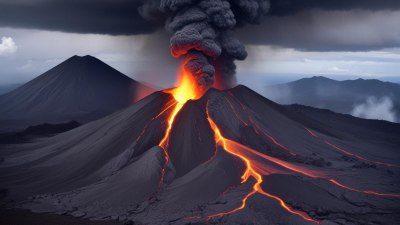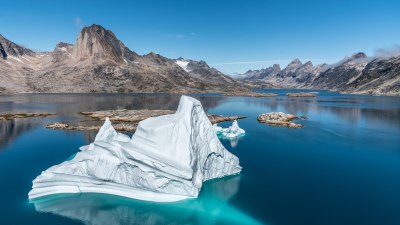How Volcanoes Create Their Own Weather
Learn how volcanic eruptions influence atmospheric conditions and create unique weather phenomena.

This image was created with the assistance of Freepik
Volcanoes are often seen as destructive forces of nature, but they also have the power to create their own weather systems. This phenomenon is a fascinating interplay between geological activity and atmospheric dynamics. Understanding how volcanoes create their own weather requires a look at the processes involved in volcanic eruptions and the subsequent effects they have on the atmosphere.
The Mechanics of Eruptions
Volcanic eruptions originate from the buildup of pressure beneath the Earth’s crust. When magma rises to the surface, it causes rocks to fracture and release gases, such as water vapor, carbon dioxide, and sulfur dioxide. As these gases escape, they can propel volcanic ash and magma into the atmosphere, leading to a host of environmental changes and weather phenomena. The volatile components released during eruptions can significantly alter local weather conditions.
Volcanic Ash and Clouds
One of the primary ways that volcanoes create their own weather is through the production of volcanic ash. When an eruption occurs, ash is ejected high into the atmosphere, where it can travel vast distances, depending on wind patterns. Volcanic ash consists of tiny glass shards, minerals, and rock fragments, which can influence atmospheric temperature and humidity. As the ash rises, it can form dense clouds that may block sunlight, leading to localized cooling.
Impact on Precipitation
The presence of volcanic ash in the atmosphere also impacts precipitation patterns. When ash particles collide with water droplets in clouds, they can facilitate the process of raindrop formation. This can lead to increased rainfall in the vicinity of the volcano. Interestingly, the injection of ash into the atmosphere can create conditions conducive to thunderstorms, as the charged particles enhance electrical activity within storm systems.
Creating Lightning
Volcanoes are known to produce spectacular lightning displays during eruptions. The electrical energy generated by the movement of ash and gases can lead to the formation of lightning bolts within the eruption column. This phenomenon occurs because the movement of ash particles creates a frictional charge, similar to how static electricity builds up on a balloon. These electric charges can discharge as lightning, contributing to the severe weather phenomena associated with volcanic eruptions.
Climate Effects
The larger the eruption, the greater the potential for climate effects. Major eruptions, such as those of Mount Pinatubo in 1991 or Krakatoa in 1883, have been linked to significant global climate anomalies. Volcanic aerosols, which are tiny particles released during eruptions, can linger in the stratosphere and reflect sunlight, leading to global cooling. These climatic changes can last for months or even years, affecting weather patterns well beyond the immediate area of the eruption.
Volcanic Fog and Smog
In addition to rain and lightning, volcanic eruptions can lead to the formation of volcanic fog, or “vog.” Vog is a type of air pollution that consists of sulfur dioxide and other volcanic gases that react with oxygen, moisture, and sunlight to create fine droplets of sulfuric acid. This can result in haze and respiratory problems for nearby populations. When mixed with atmospheric conditions, vog can also contribute to cloudy weather, adding another layer of complexity to the weather systems influenced by volcanic activity.
Case Studies: Historical Volcanic Weather Effects
Throughout history, notable volcanic eruptions have spawned weather phenomena and climate effects that were studied extensively. For instance, the eruption of Tambora in 1815 led to the infamous “Year Without a Summer” in 1816. The massive release of volcanic ash and gases caused a significant drop in temperatures across the Northern Hemisphere, leading to crop failures and food shortages. This event underscores the volcanoes' potential to influence not just localized weather but also broader climatic patterns.
Modern Observation Techniques
The study of how volcanoes influence weather has advanced significantly with modern technology. Scientists use satellites to monitor volcanic eruptions in real time, analyzing the ash plumes and gases released into the atmosphere. Remote sensing technology enables researchers to track the movement of volcanic clouds and assess their impact on both local and global weather patterns. This information is crucial for predicting hazardous weather events associated with volcanic activity.
The Importance of Monitoring and Preparedness
Given the potential for volcanoes to create their own weather systems, monitoring is essential for public safety. Proper forecasting and preparedness can mitigate the adverse effects of volcanic eruptions. This is particularly important for communities living near active volcanoes, as they can face immediate threats from eruptions, ashfall, and the resultant weather changes.
Future Implications of Volcanic Weather Changes
As climate change continues to be a pressing issue, understanding how volcanoes create their own weather becomes increasingly important. The interactions between volcanic activity and atmospheric conditions could have unpredictable consequences on global weather patterns and climate. More research is needed to unravel these complexities and better prepare for the potential challenges posed by both volcanic eruptions and climate change.
In conclusion, volcanoes are not merely geological phenomena; they can also be powerful agents of weather creation. Through the ejection of ash, gases, and heat, they can affect local and global weather systems, influencing precipitation patterns, cooling temperatures, and even creating dangerous meteorological phenomena like lightning and vog. As scientists continue to study these interactions, our understanding of the relationship between volcanoes and weather will deepen, providing valuable insights for future climate predictions and improving disaster preparedness.











